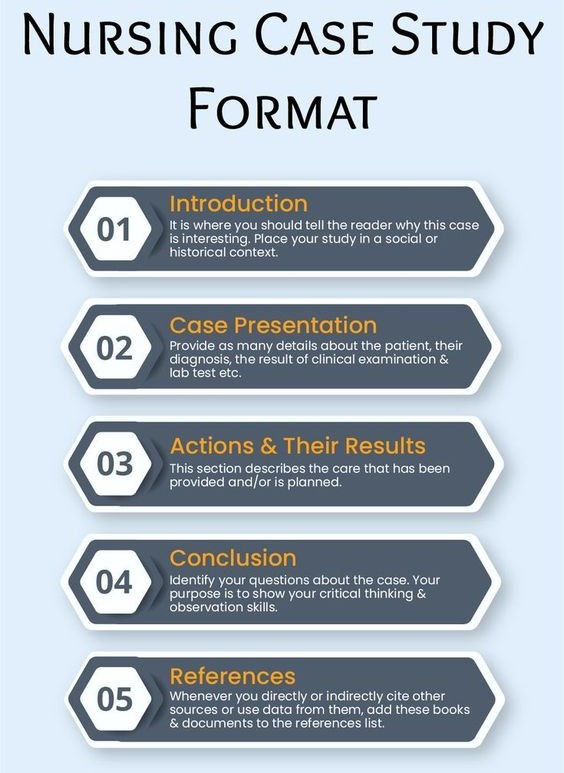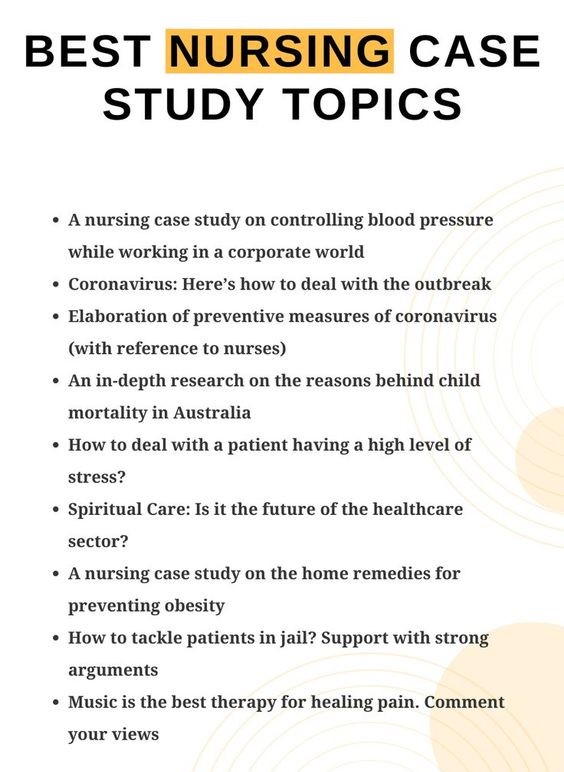Nursing case studies are more than just academic exercises; they are powerful tools for learning, sharing knowledge, and fostering critical thinking skills. These narratives delve into real-life patient experiences, providing a platform for nurses to analyze complex situations, explore diverse perspectives, and hone their clinical judgment. However, crafting a compelling and impactful nursing case study requires careful planning, a clear structure, and a commitment to ethical considerations.
This article explores key strategies to write impactful nursing case studies that resonate with readers, inspire learning, and contribute meaningfully to the field.
What is a Case Study?
A case study is a research method that involves an in-depth exploration of a particular individual, group, organization, or event. It aims to understand a complex issue or phenomenon by examining its various aspects in detail.
Here's a breakdown of what makes a case study:
Key Features:
- Focus on a specific instance: A case study doesn't look at general trends, but rather delves into the unique details of a single case.
- In-depth analysis: Researchers use a variety of data sources, including interviews, observations, documents, and artifacts, to gain a comprehensive understanding of the case.
- Real-world context: Case studies are often conducted in real-life settings, allowing researchers to examine the issue within its natural environment.
- Exploration of relationships: Case studies aim to identify the underlying causes, relationships, and factors that contribute to the phenomenon being studied.
- Qualitative and quantitative data: Case studies can utilize both qualitative (e.g., interviews, observations) and quantitative (e.g., surveys, statistical data) data to provide a holistic picture.
Types of Case Studies:
- Exploratory: To investigate a new or under-researched phenomenon.
- Descriptive: To provide a detailed account of a particular instance.
- Explanatory: To understand the cause-and-effect relationships involved in a particular situation.
- Evaluative: To assess the effectiveness of a program, intervention, or policy.
Benefits of Case Studies:
- Rich and detailed understanding: Provide a nuanced view of a complex situation.
- Real-world applicability: Findings can be directly relevant to real-life situations.
- Exploration of unique cases: Allow for investigation of unusual or exceptional phenomena.
- Generation of hypotheses: Can spark new research questions and areas of investigation.
Limitations of Case Studies:
- Limited generalizability: Findings may not be applicable to other situations or populations.
- Subjectivity: Researcher bias can influence data collection and interpretation.
- Time-consuming and resource-intensive: Case studies require significant time and effort.
Examples of Case Studies:
- Studying the impact of a new teaching method on a particular classroom.
- Analyzing the decision-making process in a company facing a crisis.
- Exploring the effectiveness of a community outreach program in addressing poverty.
In essence, a case study is a powerful research method for delving into the complexities of a specific case, providing insights that can inform our understanding of broader issues.
How to Craft a Compelling Nursing Case Study
1. Choosing the Right Case:
The foundation of a compelling nursing case study lies in the selection of an appropriate case. Consider the following factors:
- Relevance: The case should align with relevant nursing concepts and demonstrate important clinical principles. It should address current issues or highlight emerging trends in nursing practice.
- Complexity: The case should be sufficiently complex to showcase the intricacies of nursing care, allowing for insightful analysis and discussion.
- Ethical Considerations: Ensure the chosen case respects patient privacy and confidentiality. Obtain informed consent if necessary, and anonymize patient information to protect their identity.
- Patient Perspective: Explore the patient's experience, perspectives, and values. Incorporate their story and their journey, making the case relatable and emotionally impactful.
2. Establishing a Clear Structure:
A well-structured nursing case study guides readers through the narrative, ensuring clarity and a logical flow of information. Consider these essential components:

- Introduction: Briefly introduce the patient, including relevant demographic information and their presenting problem or health concern. Establish the context and introduce the case's central theme.
- Patient History: Detail the patient's relevant medical history, including past illnesses, medications, and any significant social or environmental factors influencing their health.
- Assessment: Present a thorough assessment of the patient's physical, psychological, and social well-being, including vital signs, observations, and diagnostic tests.
- Nursing Interventions: Describe the nursing interventions implemented to address the patient's needs. Include rationale for each intervention and document its impact on the patient's condition.
- Evaluation: Analyze the effectiveness of the interventions and their impact on the patient's overall progress. Discuss any challenges encountered and the strategies employed to overcome them.
- Discussion: This section offers a deeper analysis of the case, exploring its implications for nursing practice. It should:
- Connect the case to relevant nursing theories and principles.
- Discuss ethical considerations and dilemmas faced in the care of this patient.
- Identify potential areas for improvement in nursing care based on the case.
- Highlight relevant research findings and current best practices.
- Conclusion: Summarize the key takeaways from the nursing case study and reiterate its significance for nursing education and practice.
3. Employing Effective Storytelling Techniques:
Nursing case studies can be powerful tools for engaging readers and conveying complex information in a memorable way. Utilize storytelling techniques to enhance your narrative:
- Focus on the Patient: Center the narrative around the patient's story, their struggles, and their triumphs. Use their voice to express their experiences and perspectives.
- Show, Don't Tell: Instead of simply stating facts, use vivid descriptions and specific examples to illustrate the patient's situation, the nursing care provided, and the impact of interventions.
- Create a Timeline: Organize the events chronologically, ensuring a clear and coherent flow of information that guides readers through the patient's journey.
- Use Dialogue: Incorporate relevant dialogue between the nurse and the patient to bring the case to life. This can also showcase the nurse's communication skills and their ability to establish a therapeutic relationship.
- Focus on Ethical Dilemmas: Explore ethical challenges faced in the case and analyze the nurse's decision-making process. This can foster critical thinking and ethical reasoning in readers.
4. Integrating Visuals and Multimedia:
Visual aids and multimedia elements can enhance the reader's understanding of the nursing case study and create a more engaging learning experience. Consider incorporating:
- Photographs: Use photographs of the patient (with their consent) to personalize the case and enhance its emotional impact.
- Diagrams: Visualize complex concepts, such as anatomical structures or medical equipment, through clear and labeled diagrams.
- Charts and Graphs: Present data and trends related to the patient's condition, such as vital signs or lab results, in visually appealing formats.
- Videos: Short videos can showcase nursing skills, patient education techniques, or even patient testimonials to add depth and visual interest.
5. Writing with Clarity and Precision:
Clear and concise writing is essential for effective nursing case studies. Use the following guidelines:
- Use Plain Language: Avoid jargon and technical terms that may not be readily understood by all readers. If technical terms are necessary, define them clearly in context.
- Short and Concise Sentences: Keep sentences short and to the point. Complex sentence structures can hinder readability and comprehension.
- Active Voice: Employ active voice whenever possible to make the writing more direct and engaging.
- Use Headers and Subheadings: Organize the content with clear headers and subheadings to improve readability and help readers navigate the text easily.
- Proofread Carefully: Thoroughly proofread the case study for any grammatical or spelling errors before submitting it for publication or review.
6. Ensuring Ethical Considerations:
Ethical considerations are paramount in nursing case studies. Respect for patient privacy and confidentiality is crucial:
- Obtain Informed Consent: Always obtain informed consent from the patient before using their story in a nursing case study. Clearly explain the purpose of the case study and how their information will be used.
- Anonymize Patient Information: Protect the patient's identity by anonymizing any personal details that could identify them. Use pseudonyms, remove identifying information, and avoid any details that might compromise their privacy.
- Respect Confidentiality: Do not disclose any information that could be considered a breach of confidentiality, such as medical records or personal details that are not relevant to the case.
- Focus on Patient Outcomes: Emphasize the patient's positive outcomes and the positive impact of nursing care, but avoid sensationalizing or exaggerating the patient's condition.
7. Finding the Right Audience and Publication:
Consider your target audience and select a suitable platform for sharing your nursing case study. Options include:
- Academic Journals: Publish in peer-reviewed nursing journals to reach a wider audience of nursing professionals and contribute to the body of nursing knowledge.
- Nursing Education Resources: Share nursing case studies with nursing students and educators to enhance their learning and prepare them for real-world clinical practice.
- Professional Websites and Blogs: Publish nursing case studies on platforms dedicated to nursing, healthcare, or patient care to engage a broader audience.
- Social Media: Use social media platforms to share your nursing case studies and connect with colleagues, educators, and the broader nursing community.
8. Using Nursing Case Studies for Learning and Professional Development:
Nursing case studies serve as valuable tools for learning, professional development, and clinical decision-making. Consider these applications:
- Student Education: Use nursing case studies to provide students with realistic clinical scenarios and help them develop critical thinking, problem-solving, and decision-making skills.
- Continuing Education: Use nursing case studies in continuing education programs to enhance the knowledge and skills of practicing nurses.
- Quality Improvement: Analyze nursing case studies to identify areas for improvement in clinical practice and develop strategies to enhance patient care.
- Research and Innovation: Use nursing case studies to explore new nursing interventions, evaluate the effectiveness of current practices, and generate new research questions.
- Policy Development: Use nursing case studies to inform healthcare policy and advocate for changes that improve patient care.
Examples of Effective Nursing Case Studies
Several excellent nursing case studies offer inspiration and guidance for aspiring writers. Explore these examples:

- "A Case of Diabetes Mellitus" from the National Center for Case Study Teaching in Science: This case study explores the challenges of managing diabetes, focusing on patient education, self-management strategies, and the role of the nurse in supporting the patient.
- "The Case of Mrs. Jones" from the American Nurses Association: This case study follows a patient with heart failure and explores the complexities of managing chronic illness, including medication adherence, patient education, and the importance of social support.
- "The Case of Mr. Smith" from the National League for Nursing: This case study focuses on a patient with dementia and explores the challenges of providing compassionate care for individuals with cognitive impairment, including ethical considerations and communication strategies.
Nursing case studies are essential tools for learning, knowledge sharing, and promoting critical thinking skills within the nursing profession. By following these strategies, nurses can craft compelling and impactful nursing case studies that engage readers, inspire learning, and contribute meaningfully to the field. Remember to choose relevant cases, establish clear structures, employ storytelling techniques, integrate visuals, write with clarity, ensure ethical considerations, and reach the right audience. By embracing these guidelines, you can transform real-life patient experiences into valuable learning resources that empower nurses and enhance the quality of patient care.
Professional Help with Nursing Case Studies
Crafting compelling nursing case studies is usually an overwhelming task for many learners. However, you can easily avoid the stress of writing academic papers with professional help from Exemplary Dissertations. We guarantee customized nursing case studies, tailored to your specific needs and goals.